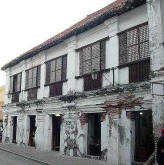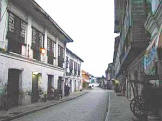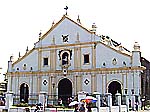
Places of Interest: Old Vigan Colonial Houses – the ancestral houses were built mostly by rich Chinese traders. These great big houses are made of thick brick walls and plastering with red clay. Tile roofs are made to survive earthquakes. The Mestizo district where more than a hundred houses line side by side along Calle Crisologo.
Old Vigan Colonial Houses – the ancestral houses were built mostly by rich Chinese traders. These great big houses are made of thick brick walls and plastering with red clay. Tile roofs are made to survive earthquakes. The Mestizo district where more than a hundred houses line side by side along Calle Crisologo.
St. Paul’s Cathedral - built in 1790-1800 by the Augustinians, this impressive Baroque cathedral has most of its interior walls well preserved. The 12 altars and 3 naives only enhances the church beauty and grandeur. The bell tower is octagonal and is located 10 meters south of the cathedral. It is a place not to be missed when visiting Vigan.
Palacio de Arzobispado – built in 1783, it is the official residence of the Archbishop of Nueva Segovia. The palace was the headquarters of Gen. Emilio Aguinaldo. Included in the palace is the Museo Nueva Segovia with a collection of paintings, manuscripts and religious articles accumulated through the centuries.
queen
-
►
2009
(8)
- ► 01/25 - 02/01 (1)
- ► 01/11 - 01/18 (7)
-
▼
2008
(142)
- ► 12/28 - 01/04 (1)
- ► 12/14 - 12/21 (3)
- ► 12/07 - 12/14 (5)
- ► 11/30 - 12/07 (2)
- ► 11/23 - 11/30 (3)
- ► 11/16 - 11/23 (3)
- ► 11/09 - 11/16 (2)
- ► 11/02 - 11/09 (1)
- ► 10/26 - 11/02 (1)
- ► 10/12 - 10/19 (6)
- ► 10/05 - 10/12 (9)
-
▼
09/28 - 10/05
(57)
- PREGNANCY GUIDE: How to Buckle Up during Pregnancy
- PREGNANCY GUIDE: Best Face Forward: Safe Beauty Pr...
- PREGNANCY GUIDE: Is My Unborn Baby Safe? The Truth...
- PREGNANCY GUIDE: Pregnant women should not wear heels
- PREGNANCY GUIDE: Decoding the Best and Worst of Pr...
- BODY AND SOUL: Take control. Does my bum look smal...
- Modern bosses are 'prehistoric'
- Take sickies and you will die
- BODY AND SOUL: How yoga can spice up your sex life
- BODY AND SOUL: Easting Mediterranean diet makes yo...
- WTF!:Model offers to sell her virginity for $2 mil...
- BODY AND SOUL: Flat out worrying about bikinis
- BODY AND SOUL: Sex secrets of the bitch and lamest
- PHILIPPINES FIESTA/FESTIVAL
- TRAVEL: PHILIPPINES: BAGUIO CITY
- TRAVEL: PHILIPPINES: PUERTO GALLERA
- TRAVEL: PHILIPPINES: METRO MANILA
- TRAVEL: PHILIPPINES: VIGAN
- TRAVEL: Tokyo's pubs are the people's choice
- TRAVEL: Japanese for beginners
- TRAVEL:Itsy-bit of heaven on Hawaii's Waikiki
- TRAVEL:Write your own LA stories
- TRAVEL:A revamped Vegas stakes its future on class
- WORLD'S BEST WEDDING DESTINATION
- AIRPORT SCANNER CONDEMNED IN AUSTRALIA!
- ENTERTAINMENT: Sharon Stone denies plan to botox y...
- ENTERTAINMENT: Heath Ledger's daughter Matilda Ros...
- ENTERTAINMENT: Demi Moore sues New Idea
- ENTERTAINMENT: At The Movies: New 'Harry Potter' f...
- ENTERTAINMENT: At The Movies:Heath Ledger among Em...
- ENTERTAINMENT: At The Movies: Disaster Movie
- ENTERTAINMENT: Jessica Alba does a Hannibal Lecter
- HOW TO CONCEIVE A BOY:Can you influence your baby'...
- PARENTING ZONE:How to Tell Stories to Young Childr...
- PARENTING ZONE: Toddler Speech Problems
- BEING A MOM:The Definitive Guide to Diaper Bags
- PARENTING ZONE: Have Kids, Will Blog
- FATHERHOOD: What Every Dad Should Know about Raisi...
- FATHERHOOD: How to Be a Better Dad
- BEING A MOM:Baby Blues vs. Postpartum Depression
- JUST MARRIED:Falling in Love all Over Again
- PARENTING ZONE: Adoption
- PREGNANCY GUIDE: Am I Pregnant?
- PREGNANCY GUIDE: Fetal Kick Counts
- CELEBRITY PARENTS
- PARENTING ZONE: How to Balance Your New Baby and Y...
- PARENTING ZONE: Toddler Nutrition Made Easy
- PARENTING ZONE: 3 Steps to Introducing Time-Outs
- PARENTING ZONE:The ABCs of Home Preschooling
- PARENTING ZONE: 5 Public Potty Pointers
- PARENTING ZONE: My Child Hits and Kicks!
- PARENTING ZONE: Is It Hip to Be Hot?
- PARIS HILTON'S FAMOUS IMPERSONATOR
- Smallest man meets woman with longest legs
- House sells for $1.75
- How to Get Paid to Work at Home Typing Online?
- TOP 5 BEST HERBAL PILLS
- ► 09/21 - 09/28 (42)
- ► 09/14 - 09/21 (7)
Blog Archive
- queenmadison
- hi i am queenmadison, and i am here to give you facts about everything under the sun. I can offer facts of the latest technology, holiday guides, lifestyle and such. Even celebrities are often talked about here in my blog.
About Me

Subscribe to:
Post Comments (Atom)



















0 comments:
Post a Comment